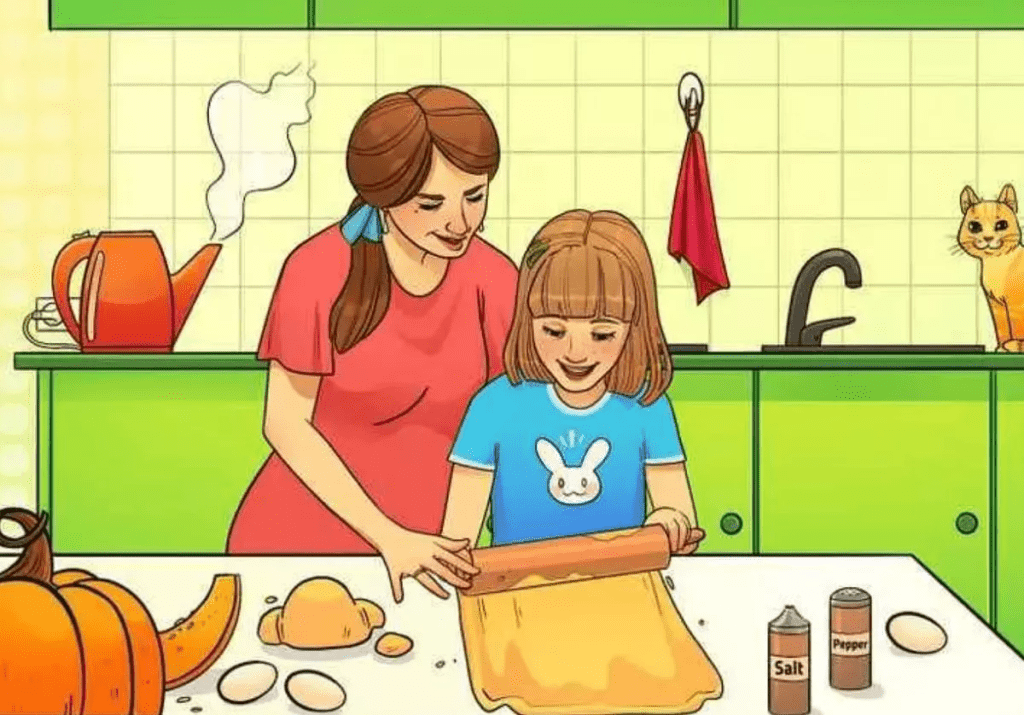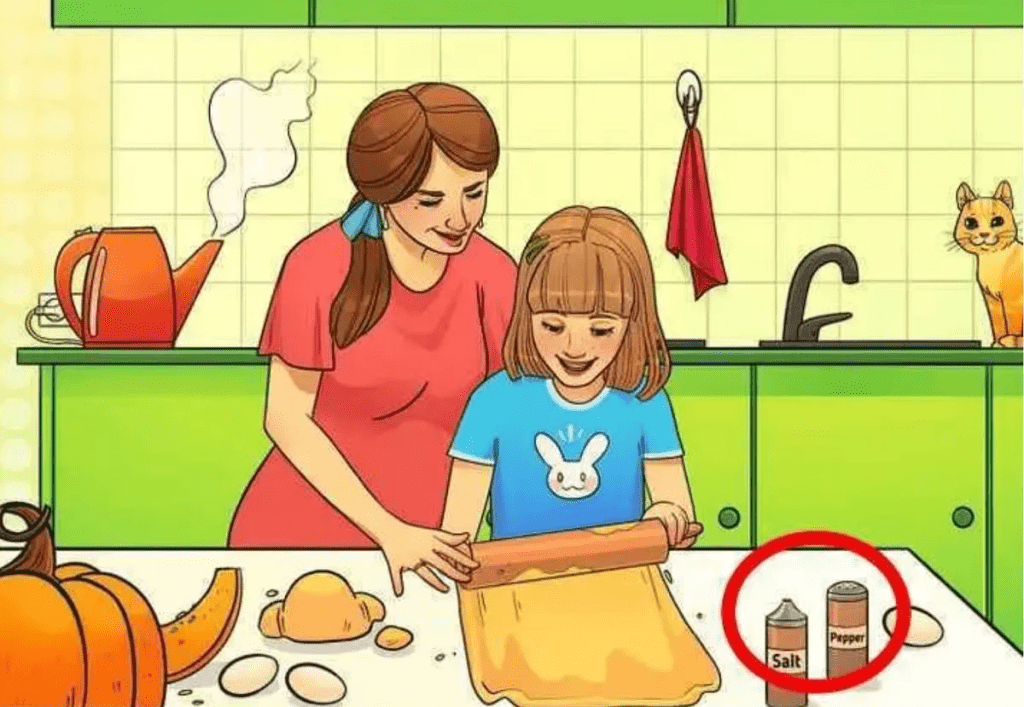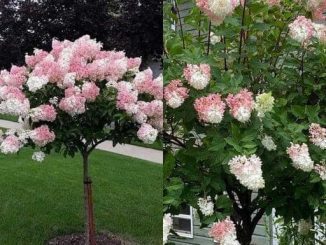At first glance, this image of a mother and daughter working together in the kitchen seems perfectly ordinary. But don’t be fooled—there are a few sneaky mistakes hidden in the scene that even the sharpest observers can miss. Most people glance at it quickly and fail to notice the small but significant errors. Think you’re up for the challenge? Let’s dive into this fun puzzle and see if you can spot what’s wrong!
The Challenge: Can You Spot What’s Off in This Picture?

In this picture, you’ll find a cozy scene of a mother and daughter seemingly preparing dough on the kitchen counter. Everything looks in place, right? But if you look closely, you’ll find that some details are just a bit off. Take a few minutes to study every item in the room—no corner or object is too small to scrutinize. This puzzle tests not only your observation skills but also your patience and attention to detail.
Ready to give it a try? Jot down what you think might be wrong, or keep reading as we guide you through the clues that make this puzzle so challenging!
Why We Often Miss Small Details in Visual Puzzles
Our brains are wired to recognize familiar scenes quickly, filling in the blanks without examining each detail. This tendency is known as “inattentional blindness,” where we overlook unexpected elements simply because they’re not what we’re looking for. In this kitchen scene, for example, you may naturally focus on the people and the main activities, ignoring subtle discrepancies in the background. Puzzles like this capitalize on this phenomenon, challenging you to slow down and truly examine what’s in front of you.
Common Mistakes People Make When Solving This Puzzle
When solving puzzles like this, people often make similar errors. Here are a few common pitfalls:
- Ignoring Background Details: We often zero in on the main characters and miss background elements, which may hold essential clues.
- Overlooking Small Objects: We tend to disregard small items like spice jars, hooks, and kitchen tools, but these often contain subtle errors.
- Assuming Familiarity: Our brains expect certain items to look a specific way in a kitchen setting, so we might not notice oddities or mismatches.
Let’s break down this picture step-by-step and examine each section carefully.
Step-by-Step Guide to Spotting the Mistakes
Ready for the solution? Here’s how to analyze each part of the image and discover what’s out of place.
1. Examine the Spice Containers
Take a closer look at the salt and pepper shakers on the counter. They seem normal at first, but upon closer inspection, you might notice that something is off. The tops of these containers are swapped! The pepper shaker has a metal top typically used for salt, and the salt shaker has the top usually found on pepper shakers. This subtle switch is easy to miss but is one of the primary errors in the image.
2. Check the Stove and Teapot
Now, focus on the stove and the red teapot in the background. The teapot appears to be steaming, which suggests it’s hot, but there’s no visible heat source under it—no flame or active burner. In real life, this would be impossible, as a teapot can’t emit steam without being heated. This small discrepancy adds a layer of unreality to the scene and is another deliberate trick in the puzzle.
3. Look at the Rolling Pin and Dough
The mother and daughter seem to be rolling out dough, a familiar and comforting activity. But if you observe the dough carefully, you might notice that its size or shape seems exaggerated. Sometimes, visual puzzles alter the dimensions of common objects to make them appear slightly unrealistic. Check if the dough looks too large, too small, or strangely shaped compared to the rolling pin and their hands.
4. Notice the Cat’s Position and Expression
On the kitchen counter, a cat is observing the mother and daughter with keen interest. While it’s not unusual to see a curious cat in the kitchen, something about this one seems slightly off. Its position or expression might be exaggerated or overly focused, diverting your attention from other parts of the scene. While the cat itself may not be an error, it serves as a distraction designed to mislead your focus.
5. Observe the Towel Hook
To the right, there’s a towel hanging on a hook. At first glance, this might seem perfectly normal, but in puzzles like this, even the most ordinary objects can contain errors. Look closely at how the towel is positioned—is the hook realistically placed, or does the towel hang in a way that defies gravity? Often, hooks and hangers are subtly misplaced or angled incorrectly, creating an unnatural appearance that’s easy to overlook.
The Solution: Here’s What’s Really Wrong in the Picture

After closely examining each detail, the key errors in this image are clear:
- Switched Salt and Pepper Shakers: The tops of the salt and pepper containers are reversed, a subtle yet intentional mismatch that challenges your attention to detail.
- Teapot with No Heat Source: The teapot is steaming despite the stove being off, an unrealistic detail that adds an oddity to the scene.
- Exaggerated Dough Size: The dough being rolled out may appear too large or oddly shaped, a classic trick in visual puzzles that subtly distorts reality.
- Unusual Cat Focus: The cat’s intense gaze may distract you, as it’s positioned to draw your eyes away from the errors around it.
- Unnatural Towel Placement: The towel on the hook may hang in an unnatural way, defying realistic positioning or gravity.
These seemingly minor mistakes are what make this puzzle so challenging. By creating an almost-realistic scene with just a few tweaks, the artist tests your observational skills and your ability to notice the details that don’t add up.
Sharpen Your Observation Skills with More Puzzles Like This!
Did you spot these errors right away, or did you need a few hints? Visual puzzles like this one are a fantastic way to hone your observation skills and boost your mental agility. The more you practice, the better you’ll get at noticing small inconsistencies in everyday scenes. It’s a fun and engaging way to train your brain and keep your mind sharp!
If you enjoyed this puzzle, share your experience with others, or try another one to keep challenging yourself. Remember, the key to success in visual puzzles is patience, a sharp eye, and a willingness to look beyond the obvious. So next time you encounter a seemingly simple image, take a closer look—you might just uncover something unexpected!


